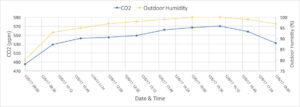Healing from the inside out: How an Iowa State research collaboration is leading to changes in office air quality
03/24/20
AMES, Iowa – Humans now spend up to 90% of their time indoors, in schools, offices, stores, restaurants or their own homes. Not surprisingly, indoor environments can impact how people live and work.
“Indoor air quality has been shown to affect people in a lot of ways, from cognitive functioning and productivity to the general health of employees. This [influence] goes beyond [that of other factors like] what the color of a room is,” said Michael Vander Ploeg, senior associate with DLR Group and a 2012 Iowa State University architecture alumnus.
DLR Group is an integrated design firm that prioritizes sustainability and energy-efficient practices. In 2014, they installed sensors in over 300,000 square feet of their own office spaces in the U.S., China and Dubai. These sensors gathered data on different elements within the buildings, such as carbon dioxide, carbon monoxide, VOCs (volatile organic compounds) and PM2.5 (particulate matter less than 2.5 micrometers in diameter). This data helps determine the quality of air and identifies when these elements may rise above recommended levels for healthy environments. If this occurs, steps can be taken to correct the issues.
Environmental data analysis
In 2018, DLR Group approached Iowa State for help in analyzing indoor environmental data gathered from its offices over several years. Architecture associate professor Ulrike Passe had been interested in indoor air quality and naturally ventilated buildings since she came to the U.S. from Germany in 2006. Her 2015 book, “Designing Spaces for Natural Ventilation: An Architect’s Guide,” co-authored with Francine Battaglia, details her research on ventilation strategies and sustainable energy use.
“You can open the windows and you can make it hot or cold, but in the end you want to ventilate for people’s comfort and air quality,” Passe said. She was the obvious choice to help DLR Group analyze their data.
Passe turned this collaboration into an opportunity for an independent research project with Farzad Hashemi, then an architecture graduate student at Iowa State. Passe supervised Hashemi as he analyzed the data and interpreted the causes and effects of different pollutant levels.
Hashemi received data from 23 U.S. offices, one in Shanghai and one in Dubai. Having such a large amount of data, he had to find a way to simplify them to begin his analysis. So, he looked at the patterns that showed significant changes in indoor air quality and used the data to identify possible explanations.

Hashemi found that when outdoor temperature and humidity are far from the comfort zone, they see higher indoor CO2 levels. There can be locations with the same number of employees, but different outdoor conditions can result in different pollutant levels. Knowing this, DLR Group discovered ways to efficiently reduce CO2 for specific locations.

“We love to collaborate with students and universities, partly because in giving these data to others, they may be able to look at things through a different lens and see things we can’t, just from being so close to it. It’s always beneficial to have that diversity of thought,” said Shona O’Dea, building analyst and senior associate at DLR Group who, with Vander Ploeg, helped initiate this data collection and analysis.
Improving indoor air quality
Monitoring indoor air quality is nothing new. It has long played a role in designing and constructing buildings to meet health and environmental codes. However, the chance to work with real-time data and compare buildings in specific environments is a new way to study indoor air quality based on the latest technology, which is always evolving and giving the industry new data every year.
“Architects need to know about indoor air quality. It’s not just about creating a space; we need to see how we can improve and what systems we need to use. After this research I’ve seen how important it is, and I always have that in my mind now,” Hashemi said.
Last September, Passe and Hashemi presented their research in collaboration with DLR Group at the IAQVEC (Indoor Air Quality, Ventilation and Energy Conservation) 2019 International Conference in Bari, Italy.
“It’s been fun to be part of this project and get to connect with ISU. With their research using our data, we can leverage that information to address solutions to indoor air-quality anomalies that have been discovered,” Vander Ploeg said. “We are an integrated design firm, so this goes beyond just architecture. We can create smarter buildings by working with our engineers to correct air-quality issues and heal the environment from the inside out.”
Hashemi is now at Penn State University working toward his PhD, but said he would enjoy the opportunity to come back and continue this research. Passe also hopes to expand this research for a new graduate student to continue as an independent study. “There are more correlations to compute and evaluate, including change over time as more data becomes available,” she said.
Contacts
Michael Vander Ploeg, DLR Group, mvanderploeg@dlrgroup.com
Ulrike Passe, Architecture, upasse@iastate.edu
Hailey Allen, Design Communications, hallen15@iastate.edu
Heather Sauer, Design Communications, hsauer@iastate.edu
-30-
